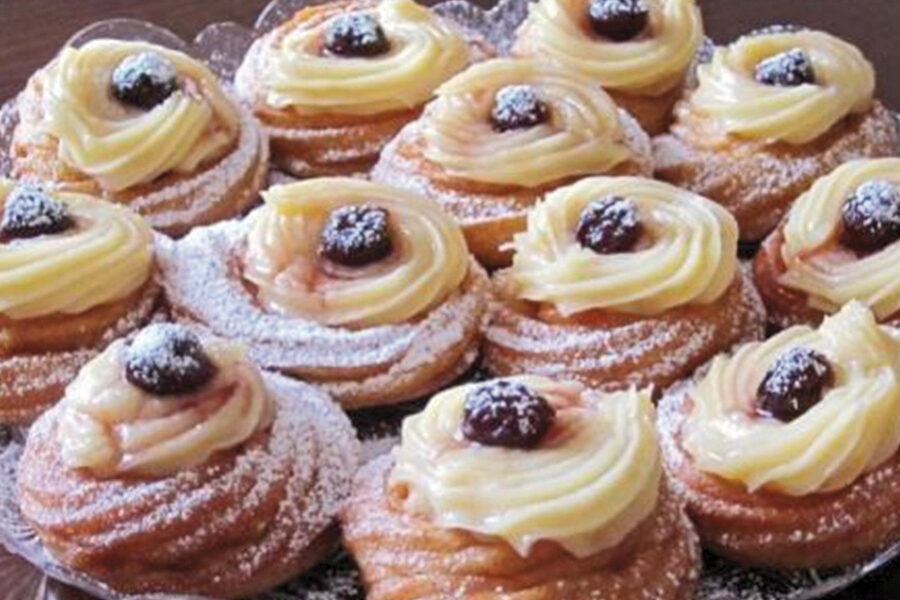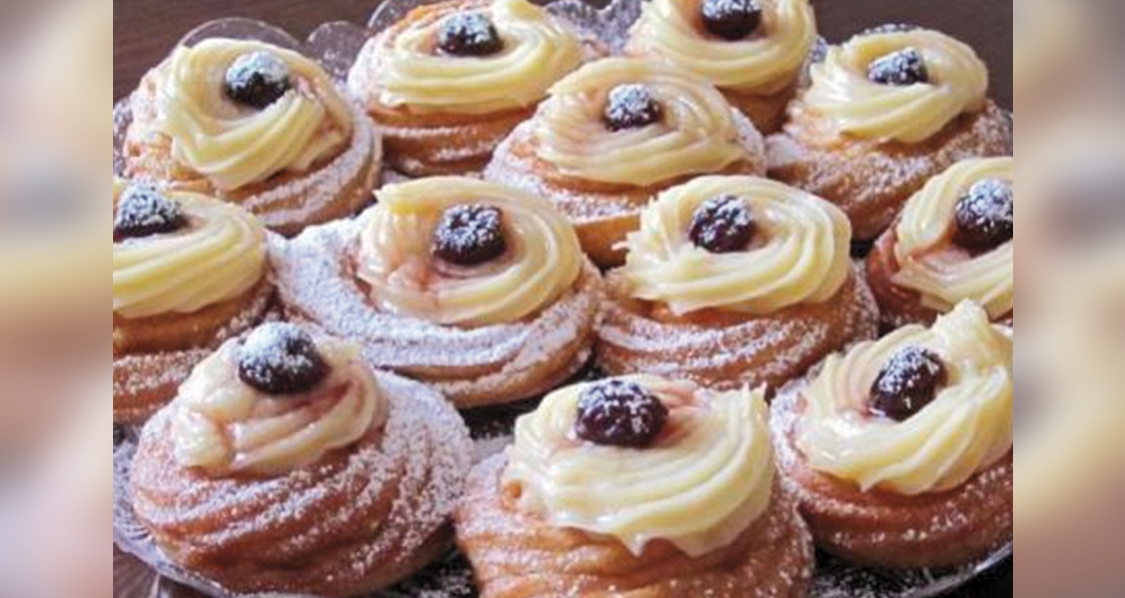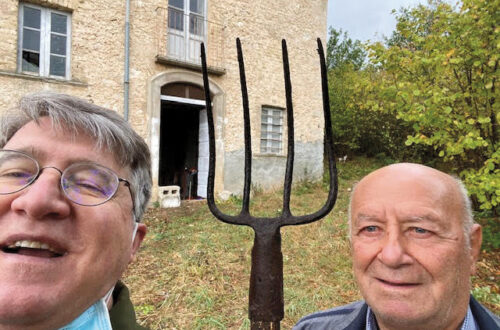
Festa di San Giuseppe and its Famous Zeppole Pastries
By Cathy Branciaroli

Photo courtesy of Little Italy San Diego
In Italy, Father’s Day is celebrated on the Festa di San Giuseppe which honors St. Joseph, the earthly father of Jesus. And, such a celebration it is. On March 19, the day of the feast, street processions are held with marchers dressed in red, special church services are conducted, elaborate displays laden with traditional foods are assembled and community spirit fills the air.
St. Joseph is the patron saint of many things including woodworkers, family life and pastry chefs. On this special day, prayers are said for his intercession in things great and small. The celebration of this feast began as one of thanks by the people of Sicily, which was experiencing a terrible drought and famine in the 1800’s. In an act of desperation, villagers prayed to St. Joseph for relief and when it came, they began the tradition of honoring him and giving thanks to others in gratitude for what they now had. The tradition soon spread to many parts of Italy including Abruzzo and Molise where it has been strongly embraced. In the U.S., this also is a special Italian feast, carried to this country by immigrants. Today it thrives in cities with large Italian communities such as Baltimore, Buffalo, San Diego and New Orleans.
Key to the feast is food, particularly the tradition called St .Joseph’s Table and its accompanying sweets, including Zeppole pastries. AMHS member and filmmaker Kirsten Keppel created a documentary focusing on this subject in 2017, which has been recognized with a number of awards. In it, parishioners from Baltimore’s Saint Leo the Great Church describe the Table’s religious, cultural and culinary aspects as well as the making of the famous Zeppole pastries. The 18-minute video is available at this link: vimeo.com/231190592.
Thirteen dishes, mostly simple ones, typically make up the Table’s fare, all of them meatless since the feast falls during Lent. The devotional fare symbolizes the plenty that followed the Sicilian famine, and its abundance is offered in hopes for future good fortune. The table is lush with oranges and lemons, overflowing with fava beans and fragrant with flowers. The meal is capped with bucatini pasta, usually con sarde e finnochio. This is sprinkled with bread crumbs, the poor man’s parmesan cheese, mimicking the sawdust of Joseph the carpenter. Bread is also distributed to friends, relatives and people in need. Finally, the sweets are presented including the Zeppole which also are called sfinge. Traditionally Zeppole only are prepared at the time of this feast. Resembling a doughnut in shape, size and texture, the dough typically is piped, fried, filled with a ricotta cream and topped with a dusting of confectioner sugar. Of course, the foods are liberally accompanied by glasses of red wine.
For those who would rather forego recreating the entire Table of foods, it’s possible to prepare just the Zeppole pastries. In support of such efforts, here is a recipe for making them, provided by PBS chef Lidia Bastianich.
| Zeppole di San Giuseppe |
|---|
| Ingredients for the Filling: 3 cups ricotta ½ cup confectioners’ sugar 1/4 cup finely diced candied orange peel 1/4 cup finely diced candied lemon peel 1/4 cup small chocolate chips or bittersweet chocolate chopped in small pieces (optional) Ingredients for the Zeppole Dough: 1 cup water 4 tablespoons unsalted butter 1 tablespoon sugar ½ teaspoon salt 1 cup unbleached flour 4 large eggs 1 teaspoon grated orange zest 1 teaspoon grated lemon zest 6 cups vegetable oil (if frying the zeppole) Confectioners’ sugar and Amarena cherries in syrup if desired |
| Preparation Combine the ricotta and ½ cup confectioners’ sugar in a food processor. Process until creamy. Add a little Grand Marnier and process until incorporated. Scrape the ricotta mixture into a bowl and stir in the candied fruits and chocolate chips. Store covered in the refrigerator until needed, up to 2 days. In a large, heavy saucepan, bring the water, butter, sugar and salt to a boil. Add the flour all at once, and beat vigorously with a wooden spoon over medium heat until the dough leaves the sides of the pan and forms a ball around the spoon. Remove from heat and quickly beat in 1 egg at a time, beating until batter is smooth after each addition. Add the orange and lemon zest and continue beating until mixture is smooth and glossy. For the fried version: In a heavy, 3-quart pot, heat the vegetable oil until a deep-frying thermometer registers 350° F. Higher temperature will cause the dough to brown before the center is fully cooked. Carefully drop rounded tablespoonfuls of the batter into the oil, about 6 at a time. (There should be enough room in the pot for the zeppole to float freely.) Fry, turning the zeppole as necessary, until golden brown on all sides, about 6 minutes. Adjust the heat under the pot to maintain the temperature of the oil as the zeppole fry. Remove with a skimmer and drain on paper towels. Repeat with the remaining batter allowing the oil to return to 350° F before continuing. For the baked version: Preheat the oven to 425° F. Drop the batter by rounded tablespoonfuls onto a lightly greased or non-stick baking pan. Bake until evenly and lightly golden brown, about 20 minutes. Reduce the oven temperature to 350 degrees F and continue baking until medium golden brown and a Zeppole feels very light when picked up from the baking sheet, about 15 minutes. Transfer to a rack and cool. Cut the Zeppole in half, leaving it attached on one side. Spoon the filling into the zeppole, dividing evenly. Dust the tops of the Zeppole with remaining confectioners’ sugar and one or two Amarena cherries in syrup. Serve at room temperature or chilled. Note from Lidia: She prefers the ricotta to simple pastry cream as being more authentic, tasting milkier and feeling more home made. But, as Lidia says, she just loves ricotta. |
(Cathy Branciaroli is a Delaware-based, award-winning food writer and a member of the AMHS. Her website, Delaware Girl Eats, has been honored nationally for its enticing posts and its narratives about the stories behind the dishes being featured.)
March/April 2022





